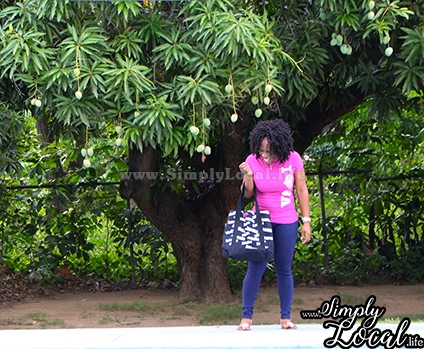I always knew that many types of mangoes were cultivated in Jamaica but like many Jamaicans, not more than a handful of names were known. With mango season upon us, I sought to find out the favourites of my social following with Facebook and Instagram posts. Some of the eye-opening responses inspired further learning, and BWOY! Jamaican mangoes species have some very “colourful” names (to say the least). A few years ago, waterfalls you probably never knew were published here, so why not share the knowledge [and laughs] of Jamaican mango names as well?
From personal knowledge, research, and queries to my people, here is a list of Jamaican mango names + descriptions [if I could find them]. Please note that as someone who mostly drinks their mangoes, I am by no means an expert, and am aware that the same mango can share multiple monikers.
If you can fill in any blanks or add further insight to the mentioned below, please add to comments.

Jump to Section:
Most Popular Jamaican Mango Types
- St. Julian / Julie – Round, with a flattish side, and has a green + red-orange tinge when ripe. A well-loved ‘creme of the crop’ among Jamaicans thanks to its juiciness and rich flavour.
- East Indian – Medium-sized with a large top and small, red or yellowish end. Stringy in texture but very sweet and juicy. Another premium mango, battling for the overall top spot in the heart of Jamaicans.
- Bombay – This type has an extremely sweet, rich and unique taste. Its flavour can be described as rich and spicy. Skin typically remains mostly green with red blush; a slight yellow color on the bottom determines its readiness to be picked. The flesh is dark orange and completely fiberless.
- Hairy/ Hairy Man / Stringy / Yellow / Common – As 1 name suggests, this mango is found just about everywhere and is 1 most Jamaicans know well. Eating these mangoes require picking the string-like fibres from ones teeth extensively, hence ‘some of the names given.
- Blackie / Fine Skin / Green Skin / Green Gauge/ Dunkell / Kidney – Sometimes smaller and less sweet than ‘hairy’ mangoes. The skin is palatable, most often green, and sometimes yellowish with black spotting when ripe.
- Number 11 – Distinctive shape, smell, and flavour. Firm flesh with a tangy taste close to the seed. Lovers of this type are known to indulge until the seed is white! Clarendon is well-known for the abundance of this popular mango.
‘People’ Jamaican Mango Names
- Graham / Gryam – Graham is said to be a seedling of the Julie mango. It has an oval shape with a round top that sometimes contains a small beak. The skin is yellow at maturity, and is bumpy. The flesh is orange, fiberless, and has a rich flavour.
- Robin – This seems to be a favourite of many. The only information I found so far is that it’s quite sweet.
- Keitt / Keith – Late bloomer with an ovoid shape and a rounded apex. Its flesh has tangy and sweet fibers, the skin colour is typically green with light red blush. It is comparatively large and can weigh quite a few pounds.
- Haden / Aden – Large and colourful variety, and can be a substantial meal. It has crimson-blushed skin with golden-yellow fiberless flesh.
- Kent – Qval shape with a rich, sweet flavour. It usually turns a greenish-yellow with some red as it matures. Its seed has a tendency to sprout inside the fruit if left on the tree too long while ripening (therefore, pick and eat it!)
- Nelson – Firm texture, similar to that of Number 11, with a rich taste similar to Bombay
- Tommy Atkins – Generally not considered to be the best in sweetness and flavour, this late bloomer is said to be great for exports due to its very long shelf life. If that’s true, hope it was considered for our recent mango export venture to the USA
- Millie – Similar in size to Number 11, with stringy flesh fibres
- Governor – Sizeable mango with fiberless flesh
- Emperor
- Hamilton
Descriptive Jamaican Mango Names
- Sweetie / Sweetie Come Brush Me / Come See – Known for its sweet, distinctive flavour as the names suggest. It is flattish, oblong, kidney-shaped, with varied colours of yellow, green, gold, orange, and red.
- Beef / Beefy – These gigantic mangoes are common in some areas, and possess firm and juicy flesh
- Long / Longy – Elongated speckled, usually with a blotched appearance. Its skin is thin and slightly bitter, but the flesh is sweet and fiberless.
- Green & Red– Round-ish mango that’s (you guessed it!) green and red in colour
- Bluie – Has skin of blue-ish hue
- Plummie – Small mango. Its name is likely comparing its size to that of a plum.
- Pawpaw / Carrot – Slightly resembles papaya (aka pawpaw) fruit and is orange in colour. Described as lusciously sweet with juicy pulp
- Cheese – Said to possess a smell and taste of cheese. Hoping that someone familair with it can determine what type of cheese…
- Turpentine / Peach Mango – Not a mango you’d want to eat when green, as it tastes “like turpentine” until ripe. Its skin colours can be a variety of bright yellow,orange, pink, purple, and red shades. When ready, the fibreless mango is sweet and juicy.
- Parrot / Pairi – Possesses a strong aroma and acid, with a spicy flavour. Has been said to carry the smell of flowers and potpourri. It is bright red in skin colour.
- Buntung – Possesses a sharp taste that tends to ‘burn’ a tongue, hence the name.
- Rusty – Said to be tough to the touch
- Hard-back – Said to be tough to the touch
- Big and So-so / Biggie / Bigso – As you imagine, this gets its name due to its large size
- Spice
- Butter
- Lady finger
- Red Jaw
- Rose
- Muddy
- Reddie
- Clapt-tongue
- Rounders
- Flaticus
‘Interesting’ Jamaican Mango Names
- Bellyfull / John Bellyfull / Full Me Belly – From the names, you probably guessed that these are really big in comparison to other types. 1 source of reading suggested it may be the same as Bombay but I’m not sure. Anyone familiar with it please feel free to confirm.
- Lippens – Ovate to oblong in shape, and averages about 1lb in weight at maturity. Its apex is rounded and lacks a beak. The skin is deep yellow and develops a pink or crimson blush at maturity. It is sweet and fiberless.
- Cowfoot – Its shape is said to resemble a cow’s hoof
- Chinch – Said to smell like bedbugs (?!?!)
- Bastard – Not sure how its name originated, but its most-found attribute refers to its size: huge
- Garden-gate / Gatey – Only description I’ve found about this one is it’s tough to the touch
- Riverside – Grown near a river
- Roadie – Grown near a roadside. Possibly the same as ‘common’ mango that passers-by tend to pick off a tree and discard its seed, eventually leading to a new tree.
- Number 7 – Said to resemble East Indian mangoes, but are smaller
- Number 10
- Number 13
- Tin-gram
- Pint o’ Water
- Back-a-kitchen
History: How Mango Arrived in Jamaica
The mango is native to India, where it has grown for more than 4000 years. It is said to be one of the oldest and ‘most important’ fruits ever cultivated; definitely one of the most loved in Jamaica! History sources state that the fruit was introduced to Jamaica in the 1700s after Lord Rodney of the English captured a French ship transporting it. The ship was reportedly destined for Hispaniola, but he brought it here instead.
Jamaican Mangoes – Green vs Ripe
While mangoes grow all over the island, Jamaican mangoes tend to be more abundant in the parishes of St. Thomas, Clarendon, St. Mary and St. Elizabeth. Depending on the variety, mangoes can be green, yellow, red or a combination when they are ripe. They can be eaten either when they are ripe or green (unripe).
When green, Jamaicans tend to cut the pulp into small pieces and add salt and/or black pepper to it. When ripe, mangoes are eaten devoured to the point of a whitewashed seed as the sticky juices run down chin, neck, and arms. Typically, ripe mangoes have a luring aroma to them. To determine if one is ripe, you can gently squeeze it to check for a degree of softness.
Besides the conventional way of mango eating by many Jamaicans, ripe mangoes are often used for juices, jams, chutnies etc. Want examples? I enjoyed a mango cream-covered dessert (photo attached) at a [discounted] vegan wellness getaway + a mango-glazed pig tail at an affordable Kingston eatery. Mmmm!



Jamaican Mango Season
I’ve always said that Jamaica’s 4 main seasons are:
- Dry season
- Mango season
- Hurricane season
- Christmas season
Mango season in Jamaica is usually between April and September, with late May – early June being the peak. Varieties boast differences in appearance, texture, taste, and scent. There are some popular mangoes while others are common only to certain parishes.
Our love for mangoes seems to exceed that of any other fruit cultivated locally. Why do I say so?
Firstly… One mango is rarely enough in a sitting for a Jamaican. We give the metric system whole new units of measurement when it comes to mangoes. Examples? A bucket of mangoes, a basin of mangoes, a wheelbarrow of mangoes… need I go on?
Secondly… During mango season you’ll see bowls of the fruit at just about every road side by vendors looking to make a profit. Some vendors actually only appear during mango season!
Thirdly… We have a whole song about it! Amongst other things, the song mentions that during this “festive” season many Jamaicans replace a typical meal with the fruit (see point #1 mentioned above).
“Mango Time” – Jamaican folk song
Mi nuh drink coffee tea mango time
Care how nice it may be mango time
In the heat of the mango crop
When di fruit dem a ripe an drop
Wash your pot turn dem down mango time
De turperntine large an fine, mango time
Robin mango so sweet, mango time
Number eleven an’ hairy skin
Pack di bankraan ram dem in
For di bankramus’ full, mango time
Mek wi do a mango walk, mango time
For is only di talk mango time
Mek wi jump pon di big jackass
Ride ‘im dung an’ no tap a pass
Mek di best a de crop, mango time

So I’ll ask you just like I did my social media following: What’s your favourite mango???
P.S. If you know a Jamaican mango specie, name, or description that’s missing from the list please add to the comments.
* Sources: Jamaica Gleaner, Jamaica Observer, Jamaicans.com, Jamaican Cookery, Dictionary of Jamaican English, bloggers travellucie and qqfoodjournal, +other mango lovers
Like this article? Pin for future travel plans!








I recently heard about pum pum mango, apparently so named because of orange-ish color…but it was probably a joke, due to the color of my gradient orange bathing suit. Negril
Loool I don’t know about that 1
Well you have call lot of mango name but the most common mango is in st Thomas in a place call mango row I am sure you never heard of it but some of the mango you name is just make up name I know mango some of yours is right here is one lockatan lot of black ants on them mango
Thanks for adding, no I haven’t heard of that mango. Would love a pic if you have 1.
Good Job Jhunelle (?)…but what is the real name for Number 11…My cousins late husband who was a foremost agriculturist in Jamaica told me that when the mangors were being brought to Jamaica the wer both named and numbered . During trasit the name tag for number 11 apparently becam dislodged and was lost so, that variety was called by its number rather than its real name. perhaps somebody from India can help if and when they taste the fruit since it too no doubt came from that country
Thanks Lem, and for that historical anecdote. Hopefully more names can be added; these are all I know of currently lol.
What you call “John Bellyfull,” I learned as “Jambellyfull,” in the Gum Drop Mountains.
Oh thank you for the insight; yet another name to add!
Bellyfull / John Bellyfull / Full Me Belly is not the same as Bombay. It is slightly similar but not the same
Thanks for that Pat! This is why I needed the disclaimer lol because I know many mangoes have many names and similarities. Appreciate your input.
During my research for our most viewed blogpost I read about 70 or more varieties. It had must be very hard work, to put all the mango names and their special properties in one post. YOU must be a biiiiiiiiiiiiiiiiiiiigggggggggggggggg mango lover 😉 Although your post is English, I like to include it in the “F – like Fruits” post, if you do not mind. We are mango lovers too, but never catched the mango season in Jamaica, if we traveled .
Sure, no mind at all 🙂 Thank you.
I have noticed that some of your posts, including this one, don’t display the images correctly on mobile devices. I don’t know if this problem is unique to my iPhone, but I just thought you should know. 🙂
Thanks, haven’t heard/noticed this before. When you say “correctly”, what do you mean exactly? Responsiveness?
I wish I could send you a screenshot. It shows the ‘codes’ rather than the actual image. I can only see the photos if I access your site from a computer.
Thanks. Will test it from an iphone and seek a resolution.
No problem.
I just read the post on computer with the Firefox-browser and had the same problem. It’s the ads that I’ve got displayed as a code, the normal photos I can see. With Chrome-browser on my Android mobile, I see everything.
Thanks for that, that’s refreshing…and I’m hoping that’s similar to what Renegade is experiencing.
Yea, I tried it from another browser, and it displayed fine.
My favorite mangoes are Bombay, Julie, Number 11, and Blackie.
My jaw is still on the floor. 65??? We are too much! These names……lmao 😂😂 I knew all the favourites and perhaps only a dozen others. Sweetie come brush me is really nice by the way, and beefy & Tommy Atkins are reserved for juice only. I hope we export some East Indian or Julie too, because Tommy Atkins is at the bottom of the barrel where mango flavour is concerned. 😢
I’m too much? Jamaicans are too much lol it’s actually like 67, and I just decided to call it a day. Tommy Atkins is apparently very popular in Florida I’ve read.
Poor Florida 😢 There’s better out there.
Dwl, I guess they take what they can get sadly.